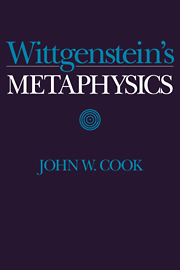Book contents
- Frontmatter
- Contents
- Preface
- List of Abbreviations
- Introduction
- Part I From Idealism to Pure Realism
- Part II The Metaphysics of Wittgenstein's Later Philosophy
- Part III Causation and Science in a Phenomenal World
- 11 Hume on Causation
- 12 Wittgenstein's Humean View of Causation
- 13 The Problem of Induction
- Part IV Logical Possibilities and the Possibility of Knowledge
- Part V The Past, Memory, and The Private Language Argument
- Name Index
- Subject Index
12 - Wittgenstein's Humean View of Causation
Published online by Cambridge University Press: 05 November 2011
- Frontmatter
- Contents
- Preface
- List of Abbreviations
- Introduction
- Part I From Idealism to Pure Realism
- Part II The Metaphysics of Wittgenstein's Later Philosophy
- Part III Causation and Science in a Phenomenal World
- 11 Hume on Causation
- 12 Wittgenstein's Humean View of Causation
- 13 The Problem of Induction
- Part IV Logical Possibilities and the Possibility of Knowledge
- Part V The Past, Memory, and The Private Language Argument
- Name Index
- Subject Index
Summary
A proper grasp of Wittgenstein's view of causation is essential for understanding many of his other philosophical views. Without such a grasp one cannot understand, for example, his ‘machine-as-symbol’ argument and so cannot understand what he says about following a rule and about the impossibility of a private language. Given what we have so far discovered about Wittgenstein's ontology, it is not difficult to anticipate his view of causation. As we saw in the preceding chapter, the idea that the world we perceive is an indeterministic world has its origin in the way Berkeley dismissed Locke's causal theory of perception: he dismissed Locke's material causes and retained the supposed effects, sensible qualities. This left him with a world in which nothing causes anything. Wittgenstein, as we have seen, also rejected Locke's causal theory in this manner, and accordingly we can expect to find that he thought we live in a world of uncaused sense-data. The Tractatus spells out very clearly the implications of this.
The Tractatus Account of Causation and Science
Wittgenstein states his basic idea with characteristic brevity: “Belief in the causal nexus is superstition” (TLP, 5.1361). He also says: “There is no compulsion making one thing happen because another has happened. The only necessity that exists is logical necessity” (TLP, 6.37)., i.e., there is no causal necessity. If we see someone falling to the pavement from a very great height, we think he is bound to be badly injured or killed, but Wittgenstein is saying that nothing is bound to happen: the man could walk away unhurt.
- Type
- Chapter
- Information
- Wittgenstein's Metaphysics , pp. 174 - 194Publisher: Cambridge University PressPrint publication year: 1994



